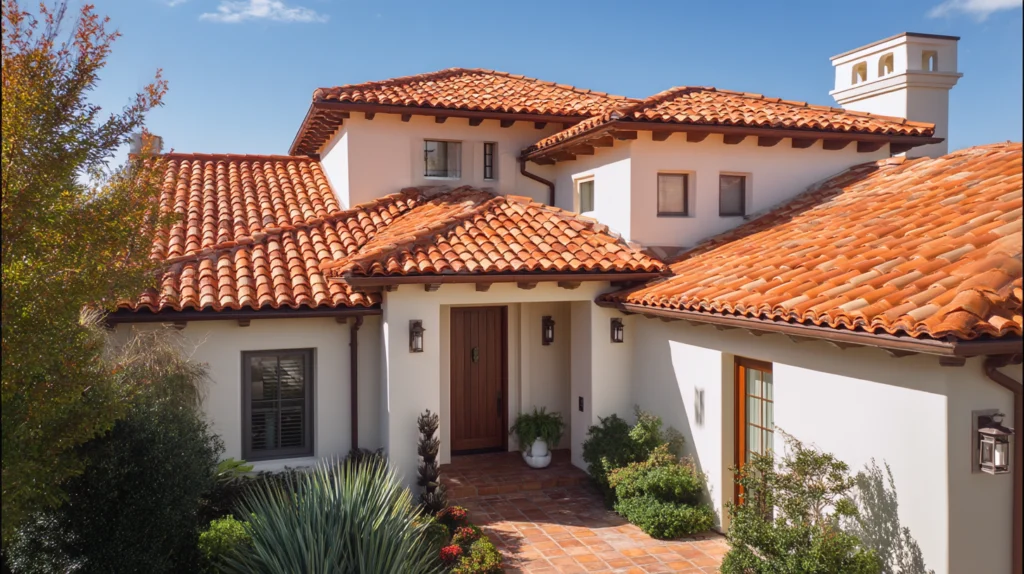Choosing between clay vs concrete roof tiles can feel overwhelming when you are planning a roofing project, but understanding the trade offs between concrete and clay tiles will help you pick the right roofing materials for your home, your budget, and your climate. In this article we compare concrete roof tiles and clay tiles, explain the differences in concrete tile installation, maintenance, energy efficiency, appearance, weight and durability, so you can choose with confidence.
What Are Clay and Concrete Roof Tiles
Clay tiles are made from natural clay that is shaped, fired in a kiln, and sometimes glazed. Clay roof tiles have a rich history dating back centuries, they often carry natural terra cotta color, and clay tiles offer long life, classic style, strong fire and UV resistance. Concrete tiles are made using cement, sand and water, molded and cured. Concrete and clay tiles both are part of the tile roof family, yet each type of tile roof shows different strengths and trade offs in cost, energy efficiency, weight, aesthetics, and required care.
Both roofing materials are far superior to many other roofing materials like asphalt shingles when it comes to lifespan, fire resistance, and curb appeal. Asphalt shingles have their place, but when you are comparing clay roof vs concrete roof, you want to think long term.
Key Differences Between Clay and Concrete Tiles
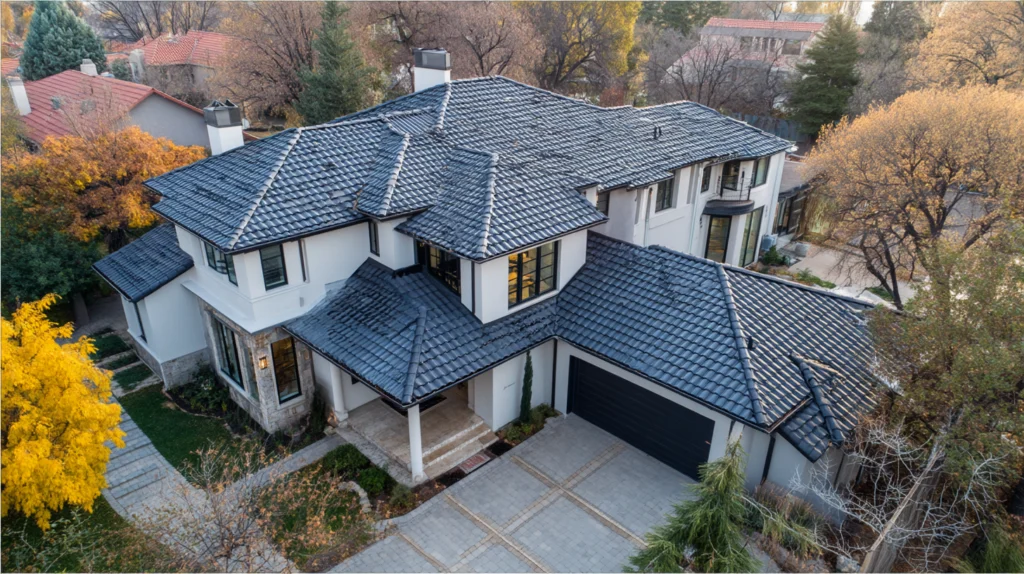
Manufacturing Process
The manufacturing process plays a crucial role in how concrete tile roof or clay tile roof will perform. Clay tiles are fired at high temperatures producing dense ceramic material, the color is baked in, natural clay itself gives the material its color. Concrete tiles are created combining cement, sand and water, often with pigments or coatings, and cured. Painted concrete tiles are available allowing more color variety, but paint or coatings may fade or require reapplication over time.
Water Absorption and Moisture Effects
One of the most important technical differences is water absorption. Clay tiles typically have a low water absorption rate around 6 percent, meaning less water is soaked into the material. Concrete tiles absorb significantly more, around 13 percent in many cases, making them more likely to stay wet longer, which can increase mildew growth, moss growth or staining problems, especially in damp climates. Low water absorption in clay tiles means less risk of freeze damage in colder climates, though clay is more fragile in freeze thaw cycles in some cases.
Weight and Structural Requirements
Concrete roof tiles tend to be heavier than clay tiles. For example concrete tiles can weigh about 40 percent more per square foot than clay tiles. That additional weight means the roof structure may require reinforcement, or framing built to stronger standards. Clay roof tiles, though heavy compared to asphalt shingles, are lighter compared to many concrete tiles. Before installing concrete and clay tiles you need to evaluate roof structure carefully to avoid problems later.
Appearance and Aesthetic Appeal
If aesthetic appeal matters, clay tiles offer that classic look, rich history, natural terra cotta color, baked in tones which resist UV exposure. Clay and concrete tiles both allow for many styles, but concrete tiles have more options in shapes, textures, and color finishes. Painted concrete tiles can mimic slate, wood shake or clay styles, giving flexibility. However painted concrete tiles may fade or discolor over time under strong UV exposure. Clay tiles have more resistance to color fade because the color is integral.
Durability, Lifespan, Weather Resistance
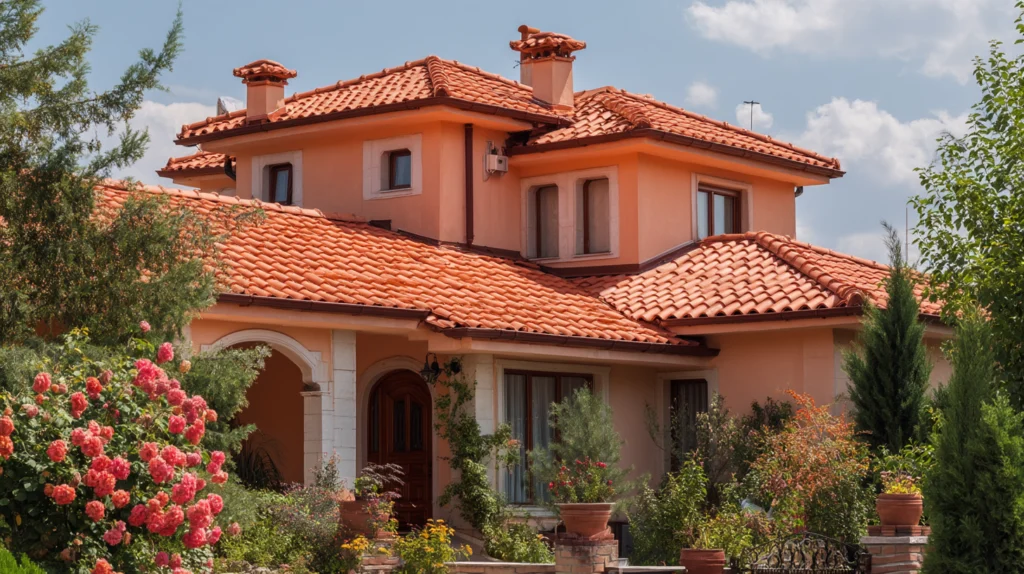
Lifespan of Clay Roof Tiles vs Concrete Tiles
Clay tiles often last 50 to 100 years or more with proper care. Concrete tiles typically last between 30 and 50 years under comparable conditions. If regular maintenance is performed, concrete tile roof life can extend, but it rarely matches clay roof tiles for sheer longevity.
Weather Resistance Across Various Weather Conditions
Because of water absorption, concrete tiles are more prone to mildew growth, moss growth or staining in moist climates. Clay tiles, with lower absorption, resist these issues better. In hot climates extreme heat can degrade painted concrete tiles faster than clay, while in colder climates freeze thaw cycles may damage clay tiles. Concrete tiles are generally more tolerant of freeze thaw if properly manufactured, but still may suffer more staining and moisture related wear. Both concrete and clay tiles perform well in strong winds if properly installed, and both offer good fire resistance.
Energy Efficiency and Environmental Impact
Both clay and concrete tiles contribute to energy efficient roofing solutions because of their thermal mass, which helps absorb heat during the day and release it more slowly at night, reducing cooling costs. Clay roof tiles generally perform better under hot climates because natural clay reflects heat better, and the shape of roof tile installations allows air circulation under tiles to improve cooling. Concrete tiles can also be energy efficient, especially when coatings or reflective paints are used, but often require extra insulation or reflective finishes to reach the same performance as clay.
In terms of environmental impact, clay tiles are more eco friendly in many ways, because natural clay is a recyclable material, less processing required, and less frequent replacement due to longer lifespan. Concrete tile production involves more cement manufacturing, greater embodied carbon, though some manufacturers use greener practices. Both concrete and clay tiles are more sustainable over lifecycle than many other roofing materials like asphalt shingles.
Cost, Installation Process, and Maintenance Needs
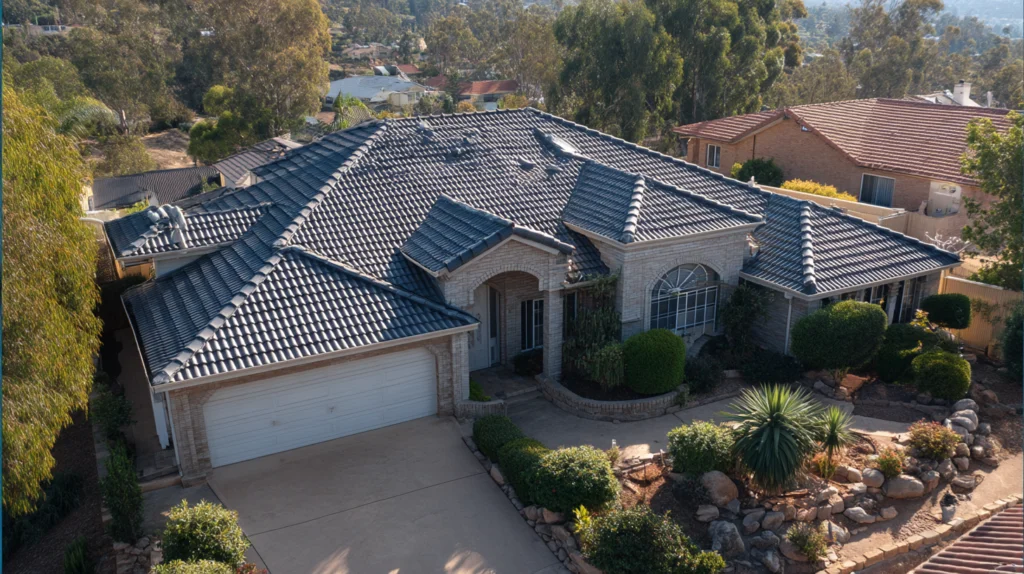
Upfront Cost and Total Cost Over Time
Concrete roof tiles are generally less expensive upfront. Concrete tiles cost less per square foot than clay tiles, including materials and labor, though paint or coating of concrete tiles, or extra structural reinforcement, can increase costs. Clay tiles are more expensive up front because natural clay material, firing, glazing or finishing add cost, and skilled labor is required. But over decades clay tile roof often gives value because it lasts longer and demands less frequent replacement.
Concrete Tile Installation vs Clay Tile Installation
Concrete tile installation requires skilled labor, but generally less fragile handling than clay. Clay roof tiles are more fragile to handle, require more care during installation, proper alignment, proper underlayment, and often require more experienced professionals to avoid breakage. For both concrete and clay tile installation, roofers must properly factor weight, roof pitch, framing support, flashing, water shedding, wind resistance in design. Installation among concrete and clay roof tiles is more complex than installing lighter roofing materials, so costs reflect that.
Maintenance Needs
Concrete tiles have higher maintenance needs especially in damp or shaded regions because mildew, moss or algae growth are more likely, and staining can occur. Painted concrete tiles require repainting or resealing over time, and cleaning more regularly. Clay tiles have lower maintenance needs, but still require periodic inspections, checking for cracked or broken tiles, cleaning debris, making sure roof structure remains strong. Both tile types require regular cleaning but frequency is higher for concrete tiles in challenging weather conditions.
Choosing the Right Tile Roof for Your Home
When comparing clay and concrete tiles for your home you should consider several factors: budget, climate, roof structure, aesthetic goals, long term maintenance tolerance, and environmental preference.
Climate and Weather Conditions Vary Based on Location
If you live in hot climates, clay roof tiles are usually better due to energy efficiency, low water absorption, and resistance to UV exposure. If your area has colder climates with freeze thaw cycles or heavy rain, concrete tiles may be more durable in some cases, but you may face more frequent maintenance. Coastal or humid climates increase mildew growth risk on concrete, so clay tiles may be beneficial.
Roof Structure and Extra Weight
Because concrete tiles impose extra weight compared to clay tiles, roof structure must be assessed. If your home’s framing is not designed for tile roof weight you may need reinforcement. If you want tiles but have limitations in roof structure, clay tiles might be lighter option among tile roof choices, though both are heavy relative to asphalt shingles. The cost of roof structure reinforcement can affect overall cost significantly.
Aesthetic Appeal and Style Preference
If you want natural terra cotta color, classic Mediterranean or Spanish style architecture clay tiles offer that authentic look. If you want more variety, painted concrete tiles offer many options, different profiles, mimic slate or wood shake or natural clay. Some homeowners choose concrete and clay tiles based on color, texture, and curb appeal. If preserving natural color and low fading is important, clay tiles may be better.
Budget vs Long Term Value
If you are willing to pay more upfront for clay tiles, you may get lower energy bills, less frequent maintenance, and longer lifespan, so total cost over time may be lower. If budget is constrained, concrete roof tiles allow design flexibility, lower initial cost, but you must plan for maintenance, potential structural upgrades, and possibly shorter lifespan.
When Both Clay and Concrete Tiles Make Sense
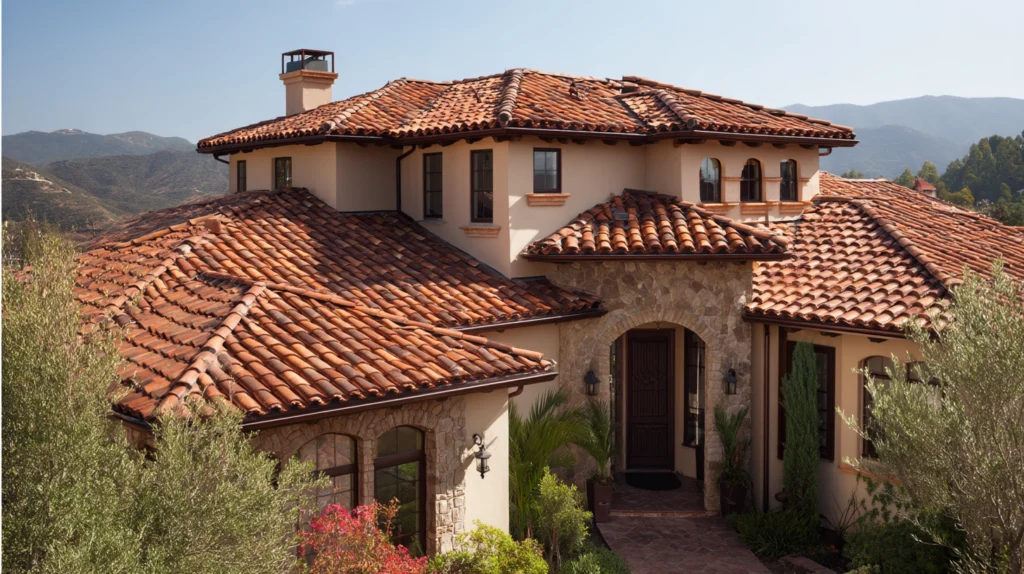
In many cases both clay and concrete tiles are viable options. For example homes in moderate climates might benefit similarly from clay and concrete tiles, choosing based on appearance or budget. Homes that want custom roof tile styles might go with concrete tiles for flexibility while still picking clay tiles for certain areas or accents. Both clay and concrete roof tiles can be used in blended roof designs. If you want certain parts of roof to highlight natural terra cotta color and other parts to have modern color palette concrete tile options give versatility.
Frequently Asked Clay vs Concrete Roof Tiles Questions
What are the main differences between clay and concrete roof tiles?
Clay tiles are made from natural clay fired at high temperatures, offering a natural terra cotta color, lower water absorption, and longer lifespan. Concrete tiles are made from cement, sand, and water, are heavier, have higher water absorption, and offer more color and style options, including painted concrete tiles.
Which tile is more durable, clay or concrete?
Clay tiles typically last longer, often over 100 years, due to their low water absorption and resistance to UV exposure. Concrete tiles usually last between 30 and 50 years but are more resistant to freeze-thaw cycles in colder climates.
How does water absorption affect roof tile performance?
Higher water absorption in concrete tiles can lead to mildew growth, moss growth, and staining, especially in damp climates. Clay tiles have a low water absorption rate, reducing these risks and making them better suited for certain weather conditions.
Are clay or concrete tiles better for hot climates?
Clay tiles perform better in hot climates due to their natural ability to reflect more heat and provide better energy efficiency, helping to reduce cooling costs.
What about the weight difference between clay and concrete tiles?
Concrete tiles are approximately 40% heavier than clay tiles, which may require additional roof structure reinforcement. Clay tiles are lighter but still heavier than asphalt shingles.
Final Thoughts on Clay vs Concrete Roof Tiles
Comparing clay vs concrete roof tiles shows that each has advantages and disadvantages. Clay tiles provide superior longevity, classic style, lower water absorption rate, natural clay beauty, high energy efficiency, natural terra cotta color options, and lower maintenance in many climates. Concrete tiles offer more style flexibility, more color options, painted concrete tiles, lower cost upfront, impact durability, ability to mimic other roofing materials, good weather resistance, though often at the cost of more maintenance and higher water absorption. Whether you choose clay roof tiles or concrete tiles depends on your roof structure, your climate weather conditions, your design aesthetic, and how much you value long term performance over upfront cost.
If you are planning a roofing project, talk with experienced professionals to inspect your roof structure, get accurate estimates comparing concrete roof and clay tiles, learn about concrete tile installation vs clay tile installation, understand maintenance needs, and calculate long term cost including energy bills and repairs. With the right choice your tile roof will give you decades of reliable protection, aesthetic appeal, energy savings and peace of mind.
